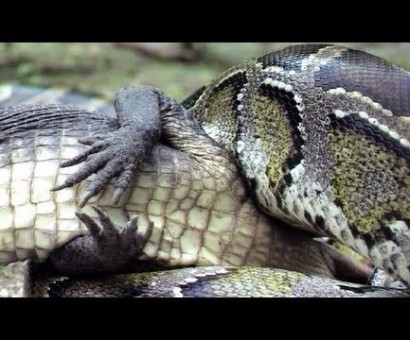Reptile DEATH match: X-rays reveal a Burmese python devouring an alligator whole
 They are both formidable predators, sitting at the top of their respective food chains. But a series of X-ray images has revealed what happens when a Burmese python, one of the largest species of snake in the world, takes on an alligator and manages to swallow it whole. The X-ray images, captured by biologists at the University of Alabama, show how the snake's digestive system kicks into overdrive to quickly break down the crocodilian's body. It organs rapidly change size and function at many times their resting rate. Professor Stephen Secor from the University of Alabama and his colleagues found that the snake’s heart increases by 40 per cent while its pancreas increases by 94 per cent and its liver more than doubles in size. The reptile’s kidney’s also increase in size by 72 per cent. The python also floods its small intestine with powerful enzymes and acid, while its metabolic rate increases by up to forty times - depending on the meal. As the digestion goes on, the python has to contend with gases produced as the bacteria in the alligators gut cause it to putrefy, stretching its stomach further. The images captured by Dr Secor and Dr Scott White reveal that within just three days the body of the alligator has already begun to break down. By day four, most of the soft tissue and most of the bones have been digested leaving just the tough skin and skeleton which passes into the large intestine where it is digested further. Following six days almost the whole 50 cm long alligator has been broken down and by day seven the entire meal has been digested. Professor Secor said the experiment had been carried out to show that a python could easily digest an alligator, which had been killed prior to being fed to the python. Although relatively small in this case, Burmese pythons have been known to take on much larger alligators and crocodiles. Burmese pythons can grow to be up to seven metres (22 feet) long but on average reach around 3.7 metres (12 feet). American alligators grow on average around four metres (13.1 feet) long while their smaller Chinese cousins rarely exceed 2.1 metres (6.9 feet). Dr Secor said: 'The images were originally taken after the finding of a large dead Burmese python in the Everglades with a dead alligator sticking out from a large gash on the side of the python. 'We wanted to demonstrate that pythons can easily digest an alligator. We followed that series of x-rays with several more while at the same time measuring the metabolic cost of digesting the alligators. 'We combined that with the same work of snakes digesting rats and pigeons, to demonstrated how different foods can vary in their duration of digestion and cost of digestion and assimilation.' He said that surprisingly the alligator was actually easier for the python to digest, despite its tough skin and scales, than other prey like rats. He told Mail Online: 'We found that the snakes actually expended less energy digesting the alligators compared to digesting the rats or pigeons.' Although rare, pythons have been recorded attacking and swallowing crocodiles and alligators in the past. On one occasion a python was discovered to have burst open after having consumed an alligator in Florida 10 years ago. It is thought the alligator had managed to kick its way out of the python. Pythons are typically ambush predators, attacking their prey by surprise and using their powerful bodies to squeeze the air from the animal. Once dead, the python can distend their jaw to swallow prey that is almost as large as they are. Writing in the Journal of Experimental Biology about some research into python digestion, Dr Secor added: ‘For the Burmese python, native to southeastern Asia, the next meal could range from a monitor lizard or ground-dwelling bird to a prey as formidable as a pangolin, deer or leopard. ’When it does eventually capture a prey and feed, the python’s previously dormant gut rapidly resumes function to tackle the difficult task of digesting a prey that may exceed half of the python’s own body mass. ‘Each meal triggers dramatic increases in metabolism, upregulation of tissue function and tissue growth. ‘Upon the completion of digestion, these postprandial responses are thrown into reverse; tissue function is collectively downregulated and tissues For such large meals the python will be almost immobile while it digests - leaving it vulnerable to attack from other predators. As a result the snake has developed a powerful digestive system. After eating, the pH of its stomach drops from 7 to 2 within 24 hours. Enzymes including pepsin start dissolving the soft tissues and skeleton of the prey within a few hours while the bacteria in the gut of the animal it has eaten also help the process. After eating, a python can then go for several weeks if not months without needing to eat again. |
























